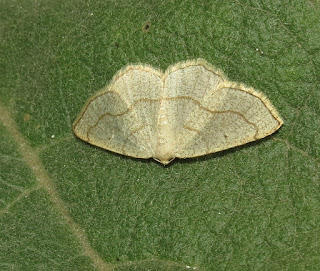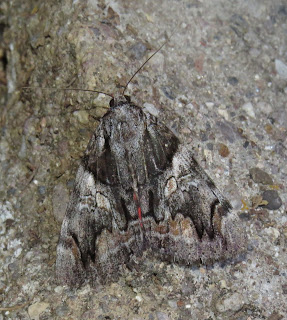Ok, where were we? Oh, that's right, we had just concluded the fourth and final day, August 30, of the New Mexico Dragonfly Blitz in southwest New Mexico, along the Gila River near Gila Cliff Dwellings National Monument. After a great dinner at Tienda del Sol, we joined Dave and Shelley Small at the home they rented in Pinos Altos, Grant County, New Mexico. There, Dave had set up some lights to attract moths and other insects.
At 7,000 feet in elevation, the habitat is dry, mixed conifer forest with oaks, too. Since it was after dark when Heidi and I arrived, it was difficult to make out many vegetation details. The insect fauna alone suggested good floral diversity. I am still a relative novice at identifying moths, even to family level, so my apologies if some images here are misidentified. I will update this post as I learn of any errors.
There were more than moths flocking to the blacklights and porch lights, though. Take true bugs for instance. Leafhoppers (family Cicadellidae) made a good showing, including a lovely green Rugosana species with red eyes.
Easily mistaken for a leafhopper was a conifer spittlebug in the genus Aphrophora (family Cercopidae or Aphrophoridae, depending on which authority you consult).
Beetles, too, were present in fair numbers and diversity. Colorful foliage ground beetles in the genus Lebia are relatively small, but draw attention with often bright metallic wing covers.
Sap beetles, family Nitidulidae, are frequently drawn to lights at night, but they also come to fermenting sap, fruits, and similar substances at all hours. I guess they are the closest things to "insect alcoholics."
Many kinds of scarab beetles find their way to lights, including small chafers in the genus Diplotaxis, and those friendly giants we were seeing everywhere, the rhinoceros beetles Xyloryctes thestalus. Clumsy as they are, I am rethinking wearing a helmet next time we do blacklighting.
Moths were mostly what Dave wanted to find, and he was not disappointed. Moth diversity is apparently inversely proportional to the size of the insect. "Micros" are where it's at, but good luck with that. Identification rests mostly on characters that are either too small, too concealed, or otherwise invisible to the average human eye or camera lens. Many species, even genera, can only be determined by dissecting the genitalia of the specimen.
With that in mind, my identifications must be regarded as mostly tenuous. Moths in the genus Ethmia, family Depressariidae, are only "depressing" in their uniform black, white, and gray colors. All the species look pretty much alike, and most of the 50-odd species north of Mexico occur in the southwest U.S. Larval host plants are overwhelmingly in the Boraginaceae, Ehretiaceae, and Hydrophyllaceae. The adults are relatively large for micros, 10-15 millimeters from nose to folded wingtip.
One of the more exotic-looking micros we found were members of the genus Aristotelia in the "twirler moth" family Gelechiidae. They are tiny, but boldly marked. Only 35 named species are known north of Mexico, but there are many more awaiting description by scientists. Each species specializes on a particular plant, but overall many families of plants serve as food for the caterpillars.
If I have the identity of this next one correct, it is a member of the genus Argyresthia, family Argyresthiidae. These are certainly true micros, only 3.2-6.8 millimeters from head to wingtip. Most are white with broad, transverse metallic stripes like the one shown here.
Larvae are miners of conifer needles or broadleaved plants. That means they feed between the layers of plant tissue. There are over fifty species known in North America.
This last micro is pretty confounding. I think I have it narrowed to Ypsolophidae or Plutellidae. You can't go too wrong because even expert lepidopterists disagree as to whether there are even two families here. "Yps" are split from "plutes" by some scientists, but not by others. Over 300 species, worldwide, fall under one or both of these families. The moths are only 6-13 millimeters long, but the forward-projecting, often banded antennae help to identify them. Caterpillars make loose silk webs on the host plant they feed on.
Ok, enough "small talk," let's look at some bigger moths. I guess some of these are still technically "micros," but at least they are large enough you can get a decent look at them. Snout moths in the family Crambidae all tend to look like this one: slender, wings often rolled around the body, and with the labial palps are greatly enlarged, heavily scaled, and projecting forward like a "snout." Larvae are associated mostly with grasses, as foliage-, root-, or stem-feeders.
A different crambid, Hydropionea fenestralis, was abundant. The wings, 12-15 mm. long, sport a lovely reticulated pattern. Amazingly, the caterpillar's life cycle remains unknown.
Members of the genus Dioryctria, family Pyralidae, could be called "coneworm moths" because the caterpillars of most feed in conifer cones, but some in foliage shoots or under bark. Twenty-five of the 40 known species north of Mexico occur in western North America. The adults are only 10-15 millimeters long.
The family Tortricidae, which includes leafroller moths, was represented as usual by our old friend the Filbertworm Moth, Cydia latiferreana, and the Codling Moth, C. pomonella.
Inchworm moths, family Geometridae, were perhaps the most diverse of the moths at the lights, and the most difficult to identify. Most, in fact, I have yet to place. "Pugs" in the genus Eupithecia are readily recognized by their narrow wings and unique resting posture.
"Emeralds" are green, but they represent several genera.
Here are a few more visitors I could not identify.
Owlet moths in the family Noctuidae were common, too, and included this stunning bird-dropping mimic, Tarache areloides.
Equally amazing were two specimens of Plagiomimicus dimidiata. The early life stages of this moth are unknown.
Members of the family Erebidae were once placed in other families, and I find it impossible to distinguish many of them from noctuids. However, there is no mistaking the very large underwing moths of the genus Catocala. We were lucky enough to have one specimen grace us with its presence. Normally, underwing moths do not come to lights, or they remain on the fringe of the lighted area if they do fly in. Heidi spotted this one in a tree, and we flushed it to where we could get better pictures.
There were other insects that are more often heard than seen, too. Tree crickets (genus Oecanthus) were still in abundance. A field cricket nymph (Gryllus sp.) made a brief appearance, too.
The most spectacular of all was a female Greater Anglewing Katydid, Microcentrum rhombifolium, apparently feeding on the mullein stalk we found her on (see image at top of this post).
This bounty of insect life also attracted predators, most of which took the form of spiders. A huge male Giant Crab Spider, Olios giganteus, prowled one doorway. One missing leg did not make him any less agile, or reduce his ability to easily negotiate the slick surface of the door, which was slightly ajar. Now that we have all returned home, I can safely disclose that the last time I saw this spider it had crawled *indoors.*
Equally adept at climbing was a parson spider, Herpyllus sp., and what I suspect was a juvenile prowling spider in the genus Syspira.
As the clock struck midnight, the increasing cold drove us to take down our set-ups and retire to the cozy confines of our respective residences. Many thanks to Dave and Shelley for their delightful company, hospitality (food and beverages especially), and sharing their blacklights. Never a dull moment. I encourage my readers to find each other and make a point of getting together informally to get to know each other, and explore together our amazing insect fauna.




























I think the Rhinocerous beetle is Xyloryctes jamaicaensis, or something close to that.
ReplyDeleteYes, Xyloryctes thestalus, as I mentioned in the post.
DeleteCan I send you a picture of the bugs that came in large numbers tonight?
ReplyDeletePlease click on the "forum" tab at the top of the page. You should have an option to include an image with your question. Thank you.
DeleteWhat, no Desert Centipedes came up? (They'll show up at lights outdoors at night so as to feed).
ReplyDeleteI lived on the lower slopes of Jack's Peak in Grant County; the insect life was incredible.